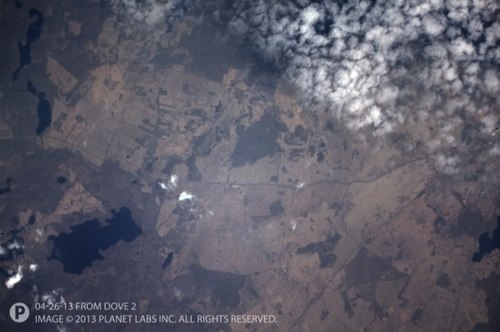
An image of the Earth taken from Planet Labs’s Dove-2 satellite in April. The company announced plans in June to launch a fleet of smallsats to provide global, frequent coverage of the Earth for commercial and humanitarian purposes. (credit: Planet Labs)
The business of commercial remote sensing—taking images of the Earth from space for sale to private or government users—isn’t new. In the late 1990s, there was a burst of activity, with three companies in the US alone developing and launching spacecraft to serve this market: DigitalGlobe, ORBIMAGE, and Space Imaging. Weak commercial demand, though, led to greater reliance on government customers, in particular the National Geospatial-Intelligence Agency (NGA), which financially supported the development of more advanced spacecraft and purchased images from them. Eventually, these companies consolidated into a single company, DigitalGlobe, a process shaped in large part on that reliance on the NGA—and cuts in the NGA budget.
A new generation of commercial remote sensing companies, though, are taking a very different approach to this industry. Rather than building a few very large and costly spacecraft to provide very high resolution images, these companies are building a larger number of smaller spacecraft that, while not able to match the spatial resolution of larger satellites, can provide much better temporal resolution: that is, they can provide follow-up images of the same area within a day or so, if not within hours. Two new ventures seeking to provide such service achieved major milestones in 2013, with more to come in 2014.
One of these companies is Planet Labs. Early in 2013, the company, then known as Cosmogia and still in its secretive “stealth mode,” raised $10.1 million from Silicon Valley-based venture capital (VC) firm Draper Fisher Jurvetson (DFJ). At the time, few details were publicly known other than it was developing smallsats, apparently for commercial remote sensing applications, with its initial demonstration satellites planned for launch early in the year as secondary payloads on Soyuz and Antares launches.
In June, after those launches, Cosmogia exited stealth mode under the Planet Labs name, showing off some of the images from the Dove-1 and Dove-2 satellites launched in April. The company said it planned to launch a constellation of CubeSat-class spacecraft that would provide medium-resolution (several meters per pixel) imagery for agricultural, natural resources, and other applications. Planet Labs launched two more Dove satellites in November as part of a cluster of smallsats on a Dnepr rocket, and in mid-December announced a $52-million Series B round, brining the total investment in the company to just over $65 million.
Just down the 101 Freeway from Planet Labs’s San Francisco offices is another commercial remote sensing company, Skybox Imaging. Skybox is also planning to deploy a constellation of smallsats, although their spacecraft are larger than Planet Labs’s—on the order of 100 kilograms, versus less than 10—and provide higher resolution images (“sub-meter,” according to the company.) Skybox has been around for a couple of years, including raising $91 million in two rounds of VC financing, but its first satellite, SkySat-1, launched in November on the same Dnepr that carried Dove-3 and -4.
SkySat-1 appears to be working well since launch. Early last month, the company released the first images of the satellite, and just last week the company released what it says is the first high-definition video taken from space (see above), brief clips from several places around the world. That gives it capabilities not available even on conventional, larger imaging satellites, and at a considerably lower cost. “The most revolutionary fact is that SkySat-1 was built and launched for more than an order of magnitude less cost than traditional sub-meter imaging satellites,” Skybox CEO Tom Ingersoll said in the company’s press release about the SkySat-1 video.
Both companies plan to launch additional satellites in 2014 as they ramp up their imagery and related products. Planet Labs has prepared its first “Flock,” or constellation of 28 satellites, that are scheduled to launch next week on Orbital Sciences Corporation’s first Cygnus cargo mission to the International Space Station (ISS). The satellites are part of the cargo contained in the Cygnus, and the satellites will be deployed from an airlock on the station a few weeks after arrival. Skybox plans to launch its SkySat-2 satellite “early” in 2014 as a secondary payload on the Soyuz launch of the Meteor-M 2 satellite, but hadn’t disclosed more details.
A different kind of commercial remote sensing company also achieved some milestones—and a setback—in 2013. Canadian company UrtheCast (pronounced like “Earth-Cast”) plans to provide high-resolution images and video from two cameras installed on the Russian segment of the ISS. A Progress cargo spacecraft delivered the cameras to the station in early December, but during a December 27th spacewalk to install the cameras, controllers failed to get telemetry from them, and cosmonauts brought the cameras back inside the station. In an update on Monday, UrtheCast officials said they believed the problem was with the ISS itself, and not the cameras, and hope to have the problem resolved and the cameras installed in a future spacewalk to be scheduled by mid-January.

Leave a Reply